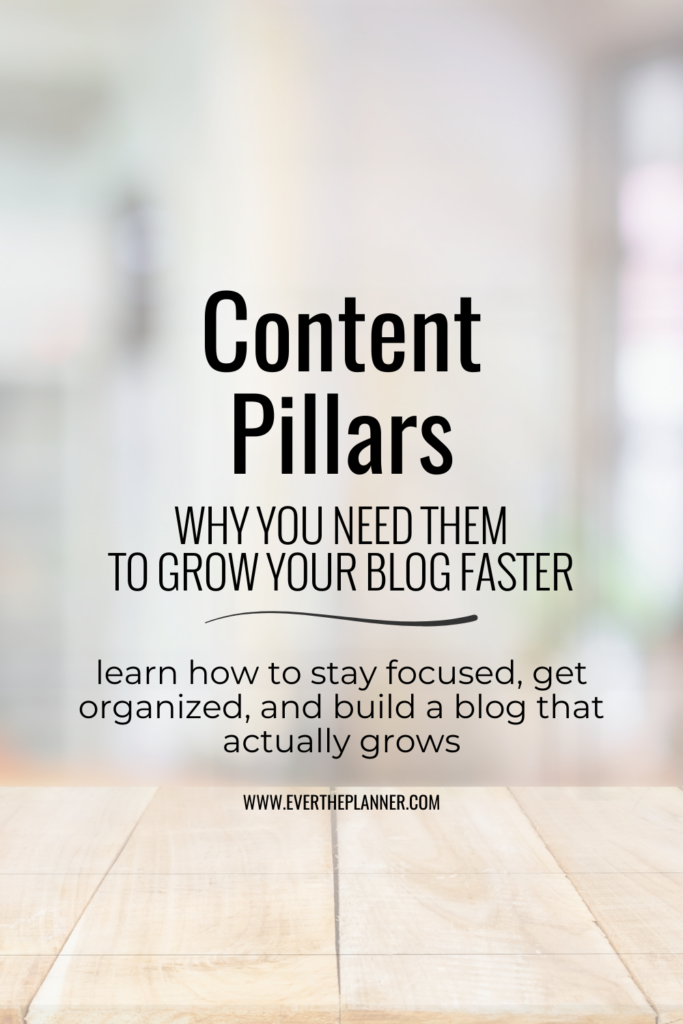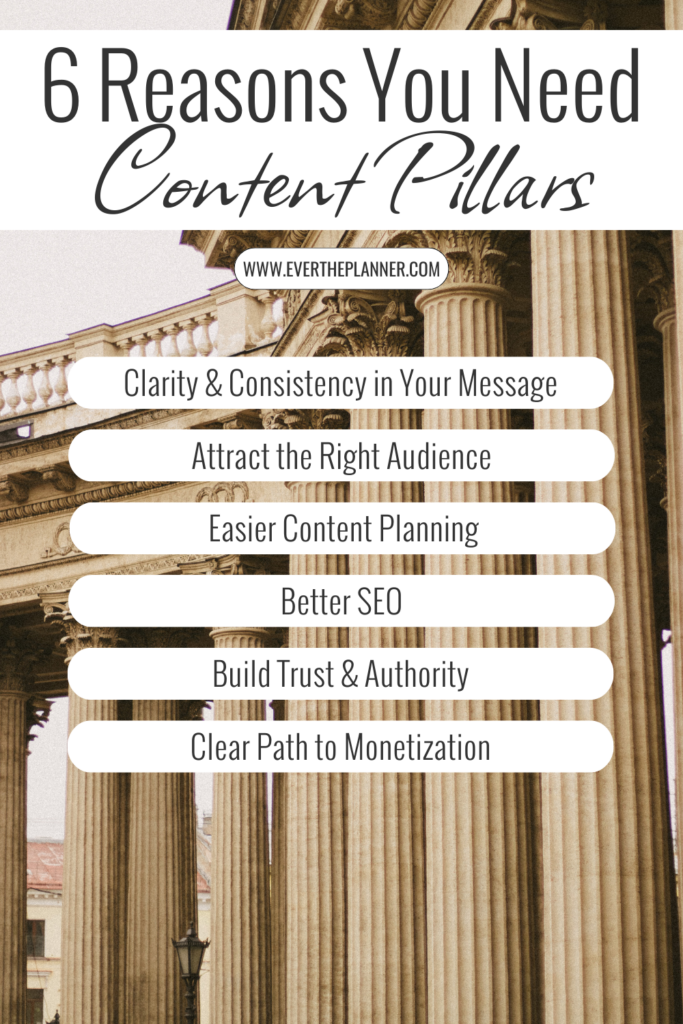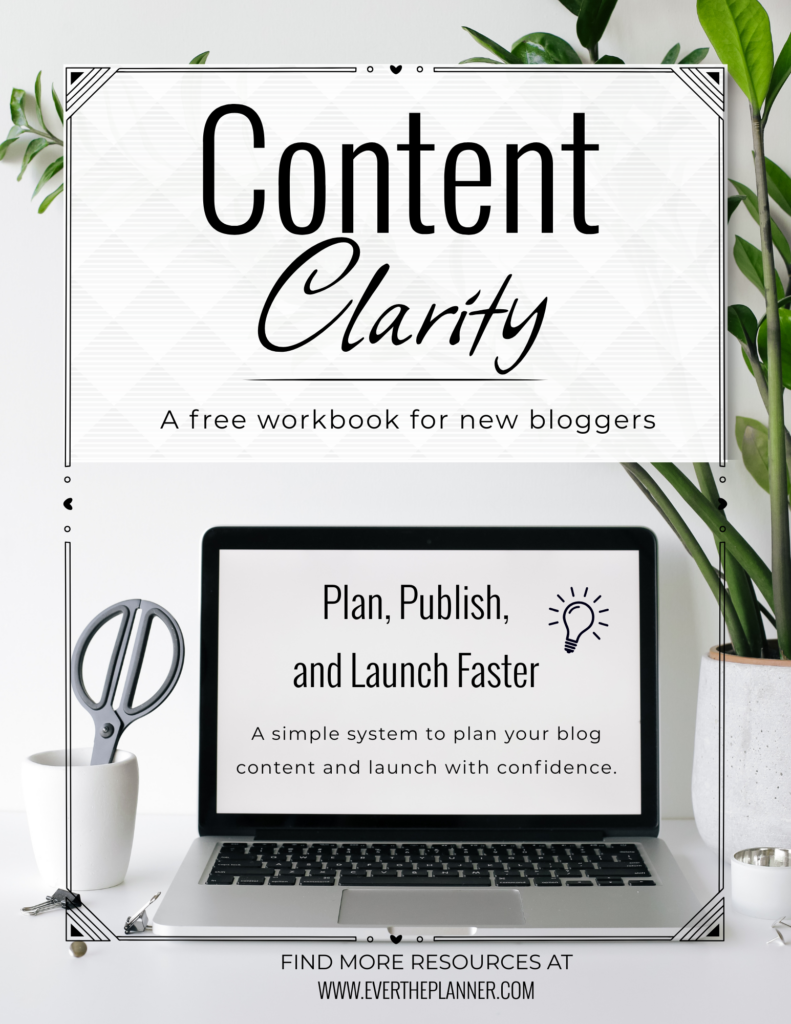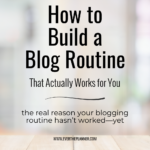Content Pillars: Why You Need Them to Grow Faster

When you’re building a blog, it’s easy to get overwhelmed by everything you could post. But content pillars help you zoom out, see the bigger picture, and stay focused on the kinds of posts that actually support your goals. Instead of throwing spaghetti at the wall, you’re building a clear, purposeful structure—one that serves both your audience and your future income streams.
When I first tried my hand at blogging back in 2018, I wanted to write about so many different things—being a mom, minimalism, productivity, routines, and relationships. My blog was spread so thin that it never really made cohesive sense.
Eventually, I laid that blog to rest. But I kept learning.
Whether you’re starting fresh or reshaping what you’ve already built, I’ve found that defining your content pillars is one of the smartest moves you can make. They help you stay consistent, attract the right readers, and turn scattered content into a clear path to growth.
When I started creating Ever the Planner, I knew I’d focus on proofreading. But the more I thought about you—the person trying to get an online business up and running quickly—the more it all clicked.
My content pillars emerged clearly: helping people plan smarter, publish faster, and start earning sooner.
TL;DR:
Content pillars help you stay focused, organized, and aligned with your goals. Instead of posting randomly, they give your blog structure—making it easier to attract the right audience and grow with intention.
Want help getting your content organized and your pillars mapped out? Grab the free Content Clarity workbook—it’ll walk you through it step by step.
This post may contain affiliate links, which means I may earn a small commission if you choose to make a purchase—at no extra cost to you. I only share products I truly believe in and think will help you grow your blog with confidence.
What Are Content Pillars?
Content pillars are the 3-5 core topics your blog is built around.
They’re not just categories—they’re the strategic backbone of your entire content plan. When you define clear pillars, you give yourself direction, your audience clarity, and your future offers a place to grow from.
Each pillar should connect to:
- What your audience wants
- What you know or offer
- Where you eventually want to earn
This is what turns a scattered blog into a purposeful, profitable one.
When I was setting up Ever the Planner, I already had my proofreading services page ready to go. I tried blogging about grammar and punctuation mistakes—but it didn’t spark an ounce of joy.
After letting my page sit for months with no traffic, no clients, and no new content, it finally clicked: I could help other bloggers polish their writing and help them get their websites up faster, plan smarter, and start earning sooner.
That’s when my content pillars stepped out of the metaphorical fog and presented themselves. They reflected what I wanted most for this site—and what I wanted to give to others like me who are short on time and mental space.
Here are what my pillars look like:
Proofreading and editing—because I offer proofreading services, and because every blog post deserves a final polish before being published, whether you hire someone or not.
Content creation and blog strategy—because I want to help others build a strong foundation and consistent content plan, so they can publish more with less mental strain.
Blog monetization—because I believe in helping people earn from their content as quickly and sustainably as possible.
Each of these pillars supports the others, while still standing strong on their own.
When your blog has strong pillars, you’re no longer stuck wondering “what should I post?”—you’re building something intentional, with content that works together and moves you forward.
Why Content Pillars Matter
If you’ve ever felt like you’re posting just to post—with no real direction—content pillars change the game. They bring structure, focus, and strategy to everything you create.
Here’s why they matter:
They build clarity and consistency in your message
When you stick to a core set of topics, your blog starts to feel cohesive. Your voice gets clearer. Your message gets sharper. And your brand? Way more recognizable.
They help you attract the right audience
Random content attracts random people. Pillar content speaks directly to the person you’re trying to help—and keeps them coming back for more.
They make content planning so much easier
When your categories are set, brainstorming becomes simple. You’re not reinventing the wheel every time you sit down to write—you’re building within a framework.
They strengthen your SEO and site structure
Google loves well-organized content. When your blog is grouped around strong, related topics, you naturally create internal links, build authority on key subjects, and give search engines more confidence in what your site is about.
They reinforce trust and authority
When readers see that you consistently talk about a few focused areas, they start to trust you. You become the go-to person for that thing. And trust is the foundation of every future product, service, or recommendation you’ll share.
If you’re not sure what your blog is about, your readers won’t be either. Content pillars give your blog a heartbeat—and your audience something to connect to.

How to Choose the Right Content Pillars for Your Blog
So how do you actually find your content pillars?
It’s not about picking random topics or trying to cover everything—you’re building a foundation that fits you, your goals, and the people you want to help.
Here’s a step-by-step process to help you uncover the right pillars for your blog.
Step 1: Start with what you know
What are you naturally drawn to and what kinds of conversations light you up?
What could you teach, write about, or share your opinion on again and again without totally burning out?
Even if you don’t consider yourself an expert, that’s okay. You just need enough perspective to help someone a step or two behind you.
For me, I’ve been drawn to online business for years. I’ve tried and failed several times, but continued watching what others were doing and picking up tips along the way.
Pay attention to who you are and what brings you joy.
Step 2: Think about who you’re helping
Your content pillars should always keep your audience in mind.
What do they want to know and what are they searching for on Google or asking ChatGPT?
What pain points, goals, or struggles are they dealing with?
If you’re not sure yet, that’s okay—this can evolve. Start with what you think your audience needs, then adjust as you learn more.
Start with the goal you think your audience is looking to achieve, and then work backward to see the steps you’ll need to cover to help them get there.
You can use tools like Answer the Public, Google Trends, and Ubersuggest to find the exact phrases people are searching for.
Step 3: Consider where you want to earn
This is the piece that often gets skipped. Your content isn’t just for fun—it’s helping lead somewhere.
What offers, services, or income streams do you want to eventually build?
When your pillars align with your income goals, you’ll find it’s much easier to create content that gently leads readers to your offers or affiliate recommendations—without sounding salesy.
Keep your strengths in mind here. If you hate creating printables, don’t make that a core income stream for your business.
You can check out my post about blog income streams to help you align your strengths with the best income stream for you.
A Quick Brainstorm to Help You Get Clarity
You can sketch this out on paper, in a digital planner, or even in a sticky note app:
- Topics I could write or teach about easily:
- Topics my audience might be searching for or struggling with:
- Where I eventually want to earn (services, products, affiliate links, etc.):
Look for the common themes that overlap across all three lists. That’s your starting point.
Need Help Getting Organized?
Grab my free workbook, Content Clarity. It’s packed with prompts and planning pages to help you choose your pillars, map your posts, and launch your blog with confidence. It’s the clarity boost you didn’t know you needed.
Real Talk: It Doesn’t Have to Be Perfect
You don’t have to get your pillars 100% perfect on day one.
You can evolve them as you grow.
But choosing something to start with gives you the focus you need to actually build momentum and get a content strategy started so that you can be consistent from day one.
Examples of Content Pillars (So You Can Steal the Structure)
Need a little inspiration? These real-world examples show how content pillars can be tailored to different niches. Use them to spark ideas for your own blog’s structure.
Productivity Blogger
- Time Management
- Focus & Routines
- Tools & Tech for Productivity
- Work-Life Balance
Wellness Coach
- Nutrition Basics
- Mental Health & Self-Care
- Fitness at Home
- Mindset & Motivation
Personal Finance Blogger
- Budgeting Tips
- Side Hustles
- Debt Payoff
- Smart Saving Strategies
Online Business Mentor
- Content Planning
- Digital Product Creation
- List Building
- Simple Monetization Strategies
Pro Tip: The best pillars are the ones that overlap a bit. You want them to stand strong on their own and support each other—like pieces of a bigger picture.
Now that you’ve seen some examples, take a moment to brainstorm your own.
Ask yourself:
- What am I passionate about sharing?
- What topics do I want to be known for?
- What will help my audience and support my offers?
Write down 3–5 pillar ideas that feel aligned with your blog’s purpose. You don’t have to get it perfect right now—this is about creating a strong, flexible foundation you can refine over time.

What to Do After You Pick Your Pillars
Once you’ve chosen your core content pillars, you’ve got the foundation—now it’s time to build on it. Here’s what to do next:
1. Brainstorm post ideas under each pillar.
Start listing blog topics that fit naturally within each one. Aim for a mix of beginner-friendly content, how-tos, personal stories, and helpful resources. Use a tool like Trello to help you organize your thoughts.
2. Use your pillars to guide your publishing calendar.
Make sure you’re rotating between your pillars so your blog stays balanced, helpful, and consistent. This is a great way to avoid burnout and keep your audience engaged.
3. Audit your existing content (if you have any).
Does it align with your pillars? If not, either revise it, re-categorize it, or let it go. From here forward, let your pillars be your filter.
4. Let your pillars shape your future offers.
Whether it’s a digital product, service, or affiliate recommendation—ideally, it should align with one of your pillars. This makes monetization feel more natural and less scattered.
5. Revisit and refine over time.
Your blog will evolve—and that’s okay. Reassess your pillars every few months to make sure they still reflect what you want to create and where you want to go.
Once you know your blog’s focus, choose a platform that can grow with you. I personally use and recommend WordPress.org for bloggers who want full control, long-term flexibility, and a strong foundation to monetize. You can grab your domain and get started quickly with SiteGround. It’s fast, reliable, and beginner-friendly. You can also check out my full post on WordPress.org here.
Final Thoughts: Let Your Pillars Be Your Guide
When your content pillars are clear, your entire blog becomes easier to manage—and more powerful. You stop guessing what to post, start attracting the right people, and create a site that’s aligned with your long-term goals.
If you’ve felt scattered or unsure about what direction your blog should take, this is your chance to start fresh—with strategy, purpose, and momentum.
Because when you know your pillars, every post has a place.
If you’re ready to stop guessing and start posting with purpose, Content Clarity will help you move forward faster.





Be the first to comment